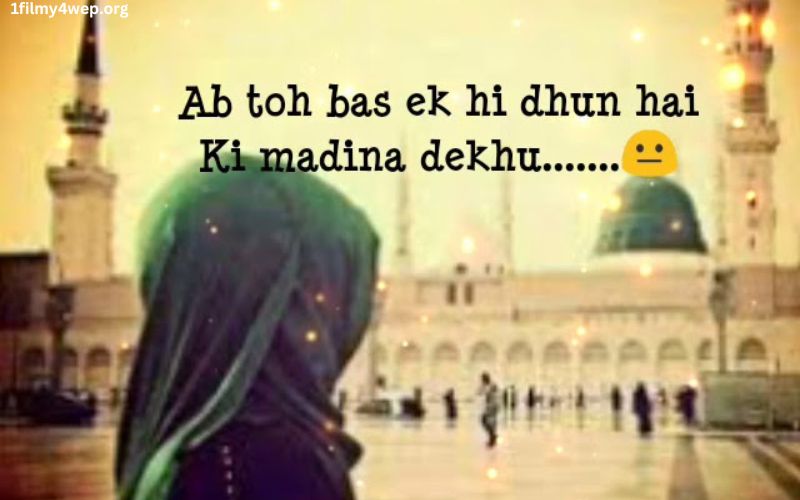Naat, a form of devotional poetry in praise of the Islamic prophet Muhammad (peace be upon him), holds a revered place in Islamic culture. “Ab To Bas Ek Hi Dhun Hai” is a timeless naat, resonating with believers for its profound expression of love and reverence for the Prophet. In this article, we’ll delve into the spiritual significance and poetic beauty of the lyrics, exploring the themes of devotion, longing, and spiritual connection.
Ab to Bas Ek Hi Dhun Hai Naat Lyrics
Ab to bas aik hi dhun hai ke Madina dekhu(n)
Ab to bas aik hi dhun hai ke Madina dekhu(n)
Aakhri umar main kiya ronaq e dunya dekhu(n)
Ab to bas aik hi dhun hai ke Madina dekhu(n)
Jaaliyan dekhu(n) ke deewar o dar o baam e Haram
Apni mazoor nigaho(n) se mein kya kya dekhu(n)
Main kahan hun ye samajh lu(n) to uthaun nazrei(n)
Dil jo sambhle to main phir Gumbad e Khazra dekhu(n)
Meray Maula meri aankhe(n) mujhe wapas karday
Taake is baar mein jee bhar ke Madina dekhu(n)
Kaash Iqbal yun hi umar basar ho meri
Subha Kaabe main to phir shaam ko Taiba dekhu(n)
Ab to bas aik hi dhun hai ke Madina dekhu(n)
Ab to bas aik hi dhun hai ke Madina dekhu(n)
Understanding the Naat Tradition
Naat, derived from the Arabic word “na’at,” meaning praise, is a poetic form deeply rooted in Islamic tradition. It serves as a means of expressing love and admiration for the Prophet Muhammad (peace be upon him) and recounting his exemplary life and character. Naat poetry is characterized by its lyrical beauty, emotional depth, and spiritual resonance, making it a cherished aspect of Islamic culture and worship.
The Essence of “Ab To Bas Ek Hi Dhun Hai”
The phrase “Ab To Bas Ek Hi Dhun Hai” translates to “Now there is only one melody.” This simple yet profound statement encapsulates the essence of the naat, emphasizing the singular focus and devotion of the believer towards the Prophet Muhammad (peace be upon him). The lyrics express a longing to immerse oneself in the love and remembrance of the Prophet, transcending worldly distractions and attachments.
Poetic Analysis
Opening Lines: Invocation of Love
The naat begins with an invocation of love and reverence:
“Ab to bas ek hi dhun hai Ke Madina dekhu”
Here, the poet declares that now there is only one melody—that of longing to behold Madina, the city of the Prophet’s (peace be upon him) final residence. This opening sets the tone for the entire naat, conveying a sense of deep yearning and spiritual aspiration.
Descriptive Imagery
Throughout the naat, the poet employs vivid imagery to evoke the beauty and sanctity of Madina:
“Ke Madina dekhu, haaye, Madina dekhu Nigaahon ko jis ki talash hai”
The desire to behold Madina is expressed with intense longing, as the poet yearns to set eyes on the city that holds profound significance in Islamic tradition. The imagery of searching gazes reflects the believer’s quest for spiritual fulfillment and closeness to the Prophet (peace be upon him).
Emotional Resonance
The naat is imbued with emotional depth, conveying a sense of love, reverence, and humility:
“Jis ke dar pe hum ghulam hai, paak hai woh Har ghulam ka bhi ghulam hai, paak hai woh”
These lines highlight the poet’s recognition of the Prophet’s (peace be upon him) exalted status and the believer’s unwavering devotion to him. The repetition of “paak hai woh” (he is pure) emphasizes the Prophet’s (peace be upon him) purity of heart and character, serving as a source of inspiration and guidance for believers.
Spiritual Significance
Love and Devotion
At its core, “Ab To Bas Ek Hi Dhun Hai” is a testament to the believer’s love and devotion to the Prophet Muhammad (peace be upon him). The naat celebrates the spiritual bond between the believer and the Prophet, emphasizing the profound impact of his teachings and example on the lives of Muslims worldwide.
Longing for Spiritual Fulfillment
The longing expressed in the naat reflects a universal yearning for spiritual fulfillment and closeness to the divine. Through the imagery of seeking Madina and beholding the Prophet’s (peace be upon him) blessed presence, the believer aspires to transcend the limitations of the material world and connect with the spiritual realm.
Cultural Context and Impact
Role in Worship and Communal Gatherings
Naat recitations hold a central place in Islamic worship and communal gatherings, serving as a means of invoking blessings and expressing gratitude towards the Prophet Muhammad (peace be upon him). “Ab To Bas Ek Hi Dhun Hai” is often recited during religious gatherings, weddings, and other auspicious occasions, fostering a sense of spiritual unity and devotion among believers.
Cultural Heritage and Identity
The naat tradition is an integral part of Islamic cultural heritage, passed down through generations as a source of inspiration and solace. “Ab To Bas Ek Hi Dhun Hai” has become a beloved part of this heritage, resonating with believers across linguistic and cultural boundaries. Its timeless message of love and devotion continues to inspire Muslims around the world.
Conclusion
“Ab To Bas Ek Hi Dhun Hai” is more than just a naat—it is a lyrical masterpiece that captures the essence of Islamic spirituality and devotion. Through its evocative imagery and heartfelt expression, the naat invites believers to immerse themselves in the love and remembrance of the Prophet Muhammad (peace be upon him), transcending worldly distractions and attachments.
As believers recite and reflect upon the words of “Ab To Bas Ek Hi Dhun Hai,” they are reminded of the timeless beauty and significance of naat poetry in Islamic culture. In a world filled with turmoil and uncertainty, the naat serves as a source of solace, inspiration, and spiritual renewal, guiding believers on their journey towards closeness to the divine.

